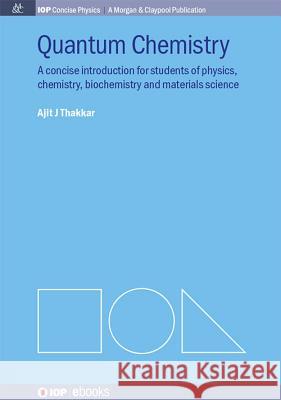Quantum Chemistry: A Concise Introduction for Students of Physics, Chemistry, Biochemistry and Materials Science » książka
Quantum Chemistry: A Concise Introduction for Students of Physics, Chemistry, Biochemistry and Materials Science
ISBN-13: 9781627054164 / Angielski / Miękka / 2014 / 124 str.
Quantum Chemistry: A Concise Introduction for Students of Physics, Chemistry, Biochemistry and Materials Science
ISBN-13: 9781627054164 / Angielski / Miękka / 2014 / 124 str.
(netto: 250,87 VAT: 5%)
Najniższa cena z 30 dni: 262,68
ok. 16-18 dni roboczych.
Darmowa dostawa!
All chemists and many biochemists, materials scientists, engineers, and physicists routinely use spectroscopic measurements and electronic structure computations to assist and guide their work. This book is designed to help the non-specialist user of these tools achieve a basic understanding of the underlying concepts of quantum chemistry. The emphasis is on explaining ideas rather than on enumeration of facts and/or the presentation of procedural details. The book can be used to teach introductory quantum chemistry to second- or third-year undergraduates either as a stand-alone one-semester course or as part of a physical chemistry or materials science course. Researchers in related fields can use the book as a quick introduction or refresher. The foundation is laid in the first two chapters which deal with molecular symmetry and the postulates of quantum mechanics, respectively. Symmetry is woven through the narrative of the next three chapters dealing with simple models of translational, rotational, and vibrational motion that underlie molecular spectroscopy and statistical thermodynamics. The next two chapters deal with the electronic structure of the hydrogen atom and hydrogen molecule ion, respectively. Having been armed with a basic knowledge of these prototypical systems, the reader is ready to learn, in the next chapter, the fundamental ideas used to deal with the complexities of many-electron atoms and molecules. These somewhat abstract ideas are illustrated with the venerable H"uckel model of planar hydrocarbons in the penultimate chapter. The book concludes with an explanation of the bare minimum of technical choices that must be made to do meaningful electronic structure computations using quantum chemistry software packages. I urge readers who may be afraid of tackling quantum chemistry to relax. Rumors about its mathematical content and difficulty are highly exaggerated. Comfort with introductory calculus helps but an ope
This book is designed to help the non-specialist user of spectroscopic measurements and electronic structure computations to achieve a basic understanding of the underlying concepts of quantum chemistry. The book can be used to teach introductory quantum chemistry to second-or third-year undergraduates either as a stand-alone one-semester course or as part of a physical chemistry or materials science course. Researchers in related fields can use the book as a quick introduction or refresher.











